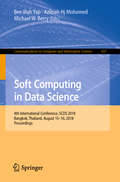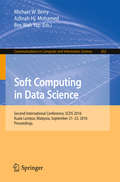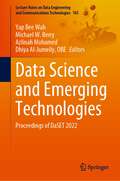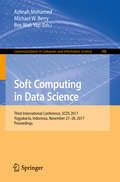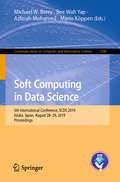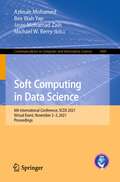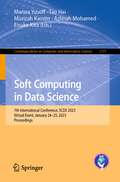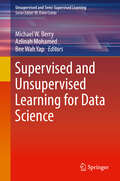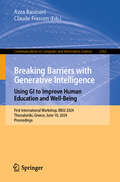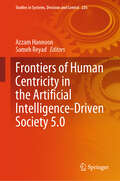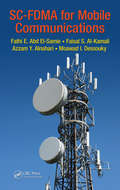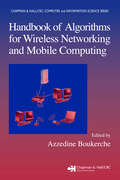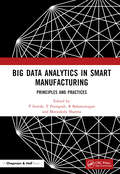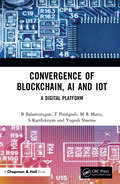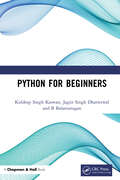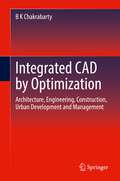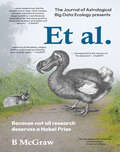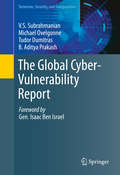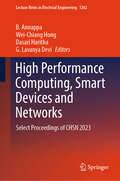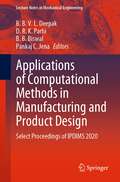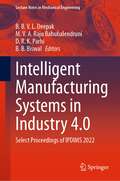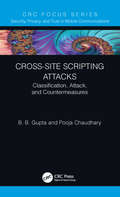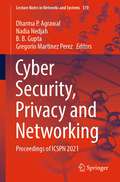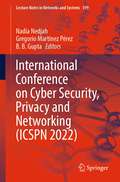- Table View
- List View
Soft Computing in Data Science: First International Conference, Scds 2015, Putrajaya, Malaysia, September 2-3, 2015, Proceedings (Communications In Computer And Information Science #545)
by Michael W. Berry Bee Wah Yap Azlinah Hj MohamedThis book constitutes the refereed proceedings of the 4th International Conference on Soft Computing in Data Science, SCDS 2018, held in Bangkok, Thailand, in August 2018.The 30 revised full papers presented were carefully reviewed and selected from 75 submissions. The papers are organized in topical sections on machine and deep learning, image processing, financial and fuzzy mathematics, optimization algorithms, data and text analytics, data visualization.
Soft Computing in Data Science
by Michael W. Berry Azlinah Hj. Mohamed Bee Wah YapThis book constitutes the refereed proceedings of the International Conference on Soft Computing in Data Science, SCDS 2015, held in Putrajaya, Malaysia, in September 2015. The 25 revised full papers presented were carefully reviewed and selected from 69 submissions. The papers are organized in topical sections on data mining; fuzzy computing; evolutionary computing and optimization; pattern recognition; human machine interface; hybrid methods.
Data Science and Emerging Technologies: Proceedings of DaSET 2022 (Lecture Notes on Data Engineering and Communications Technologies #165)
by Michael W. Berry Dhiya Al-Jumeily Azlinah Mohamed Yap Bee WahThe book presents selected papers from International Conference on Data Science and Emerging Technologies (DaSET 2022), held online at UNITAR International University, Malaysia, during December 20–21, 2022. This book aims to present current research and applications of data science and emerging technologies. The deployment of data science and emerging technology contributes to the achievement of the Sustainable Development Goals for social inclusion, environmental sustainability, and economic prosperity. Data science and emerging technologies such as artificial intelligence and blockchain are useful for various domains such as marketing, health care, finance, banking, environmental, and agriculture. An important grand challenge in data science is to determine how developments in computational and social-behavioral sciences can be combined to improve well-being, emergency response, sustainability, and civic engagement in a well-informed, data-driven society. The topics of this book include, but not limited to: artificial intelligence, big data technology, machine and deep learning, data mining, optimization algorithms, blockchain, Internet of Things (IoT), cloud computing, computer vision, cybersecurity, augmented and virtual reality, cryptography, and statistical learning.
Soft Computing in Data Science
by Michael W. Berry Bee Wah Yap Azlinah MohamedThis book constitutes the refereed proceedings of the International Conference on Soft Computing in Data Science, SCDS 2015, held in Putrajaya, Malaysia, in September 2015. The 25 revised full papers presented were carefully reviewed and selected from 69 submissions. The papers are organized in topical sections on data mining; fuzzy computing; evolutionary computing and optimization; pattern recognition; human machine interface; hybrid methods.
Soft Computing in Data Science: 5th International Conference, SCDS 2019, Iizuka, Japan, August 28–29, 2019, Proceedings (Communications in Computer and Information Science #1100)
by Michael W. Berry Mario Köppen Bee Wah Yap Azlinah MohamedThis book constitutes the refereed proceedings of the 5th International Conference on Soft Computing in Data Science, SCDS 2019, held in Iizuka, Japan, in August 2019. The 30 revised full papers presented were carefully reviewed and selected from 75 submissions. The papers are organized in topical sections on information and customer analytics; visual data science; machine and deep learning; big data analytics; computational and artificial intelligence; social network and media analytics.
Soft Computing in Data Science: 6th International Conference, SCDS 2021, Virtual Event, November 2–3, 2021, Proceedings (Communications in Computer and Information Science #1489)
by Michael W. Berry Bee Wah Yap Azlinah Mohamed Jasni Mohamad ZainThis book constitutes the refereed proceedings of the 6th International Conference on Soft Computing in Data Science, SCDS 2021, which was held virtually in November 2021. The 31 revised full papers presented were carefully reviewed and selected from 79 submissions. The papers are organized in topical sections on AI techniques and applications; data analytics and technologies; data mining and image processing; machine & statistical learning.
Soft Computing in Data Science: 7th International Conference, SCDS 2023, Virtual Event, January 24–25, 2023, Proceedings (Communications in Computer and Information Science #1771)
by Marina Yusoff Azlinah Mohamed Tao Hai Murizah Kassim Eisuke KitaThis book constitutes the refereed proceedings of the 7th International Conference on Soft Computing in Data Science, SCDS 2023, which was held virtually in January 2023. The 21 revised full papers presented were carefully reviewed and selected from 61 submissions. The papers are organized in topical sections on artificial intelligence techniques and applications; computing and optimization; data analytics and technologies; data mining and image processing; mathematical and statistical learning.
Supervised and Unsupervised Learning for Data Science (Unsupervised and Semi-Supervised Learning)
by Michael W. Berry Bee Wah Yap Azlinah MohamedThis book covers the state of the art in learning algorithms with an inclusion of semi-supervised methods to provide a broad scope of clustering and classification solutions for big data applications. Case studies and best practices are included along with theoretical models of learning for a comprehensive reference to the field. The book is organized into eight chapters that cover the following topics: discretization, feature extraction and selection, classification, clustering, topic modeling, graph analysis and applications. Practitioners and graduate students can use the volume as an important reference for their current and future research and faculty will find the volume useful for assignments in presenting current approaches to unsupervised and semi-supervised learning in graduate-level seminar courses. The book is based on selected, expanded papers from the Fourth International Conference on Soft Computing in Data Science (2018).Includes new advances in clustering and classification using semi-supervised and unsupervised learning;Address new challenges arising in feature extraction and selection using semi-supervised and unsupervised learning;Features applications from healthcare, engineering, and text/social media mining that exploit techniques from semi-supervised and unsupervised learning.
Breaking Barriers with Generative Intelligence. Using GI to Improve Human Education and Well-Being: First International Workshop, BBGI 2024, Thessaloniki, Greece, June 10, 2024, Proceedings (Communications in Computer and Information Science #2162)
by Claude Frasson Azza BasiouniThe book constitutes the proceedings for the First International Conference on Breaking Barriers with Generative Intelligence, BBGI 2024, held in Thessaloniki, Greece, on June 10, 2024. This Workshop is part of the 20th International Conference on Intelligent Tutoring Systems (ITS2024) which was held in Thessaloniki, from June 10 to June 13, 2024. The 19 full papers and 1 short paper included in this volume were carefully reviewed and selected from a total of 24 submissions. Breaking Barriers with Generative Intelligence delves into how GI in AI improves human education and well-being. This interdisciplinary event brought together professionals from academia, industry, and government to address AI ethics, human-AI interaction, and the societal implications of GI. Participants learned to tackle social concerns and promote diversity in research and development through keynote presentations, panel discussions, and interactive workshops.
Frontiers of Human Centricity in the Artificial Intelligence-Driven Society 5.0 (Studies in Systems, Decision and Control #226)
by Azzam Hannoon Sameh ReyadAccording to Serpa (in MDPI encyclopedia) [3], Society 5.0 can be realized as a concept and a guide for social development, with a profound impact on current societal structures in multiple levels. Society 5.0 achieves advanced convergence between cyberspace and physical space, enabling AI-based on big data and robots to perform or support as an agent the work and adjustments that humans have done up to now. Deguchi et al., [4] define Society 5.0 as a highly intelligent society based on generation, processing, exchange of data, and more specifically knowledge, through the connection of the physical environment with the cyberspace. Achieving Society 5.0 with these attributes would enable the world to realize economic development while solving key social problems. It would additionally contribute to achieving the SDGs established by the United Nations. Despite the differences in formulation of the names of these periods and societies, it is obvious that each of them became a basis for step like growth in developed society; at, specific time periods, scale, character and depth of these changes are different in different countries. Consequently, to address the aims of the book, it seeks exploratory, empirical, interpretive, and theoretical research built on either primary or secondary data. The approaches suggested are not exhaustive and can be extended upon by the researchers. In addition, the book will contribute towards the UN’s sustainable development goals. In support of UN’s efforts towards a more digital economy, this book aims to debate and discuss the history, genesis, future, opportunities, and challenges of transitioning to Society 5.0. and provides a holistic perspective on a variety of topics special topics which contribute towards the optimal attainment of the SDGs, particularly in terms of socialdimensions. Finally, this book provides a platform for researchers, academics, and professionals to the transition and technological enablers of industrial revolutions through empirical or exploratory studies that use a variety of innovative approaches. The target audience of the book includes researchers and scholars who will find in its comprehensive knowledge about industry 4, industry 5, society 5 and its contribution to economic growth and sustainable development goals (SDGs). Furthermore, the book’s secondary target audience are teachers, managers, strategists, professionals, governments, and policymakers.
SC-FDMA for Mobile Communications
by Fathi E. Abd El-Samie Faisal S. Al-kamali Azzam Y. Al-nahari Moawad I. DessoukySC-FDMA for Mobile Communications examines Single-Carrier Frequency Division Multiple Access (SC-FDMA). Explaining this rapidly evolving system for mobile communications, it describes its advantages and limitations and outlines possible solutions for addressing its current limitations.The book explores the emerging trend of cooperative communicatio
Handbook of Algorithms for Wireless Networking and Mobile Computing (Chapman & Hall/CRC Computer and Information Science Series)
by Azzedine BoukercheThe Handbook of Algorithms for Wireless Networking and Mobile Computing focuses on several aspects of mobile computing, particularly algorithmic methods and distributed computing with mobile communications capability. It provides the topics that are crucial for building the foundation for the design and construction of future generations of mobile and wireless networks, including cellular, wireless ad hoc, sensor, and ubiquitous networks. Following an analysis of fundamental algorithms and protocols, the book offers a basic overview of wireless technologies and networks. Other topics include issues related to mobility, aspects of QoS provisioning in wireless networks, future applications, and much more.
Comparative Genomics: 16th International Conference, RECOMB-CG 2018, Magog-Orford, QC, Canada, October 9-12, 2018, Proceedings (Lecture Notes in Computer Science #11183)
by Mathieu Blanchette Aïda OuangraouaThis book constitutes the proceedings of the 16th International Conference on Comparative Genomics, RECOMB-CG 2018, held in Magog-Orford, QC, Canada, in October 2018.The 18 full papers presented were carefully reviewed and selected from 29 submissions. The papers cover topics such as: genome rearrangements; genome sequencing; applied comparative genomics; reconciliation and coalescence; and phylogenetics.
Big Data Analytics in Smart Manufacturing: Principles and Practices
by T Poongodi Meenakshi Sharma P Suresh B BalamuruganThe significant objective of this edited book is to bridge the gap between smartmanufacturing and big data by exploring the challenges and limitations. Companiesemploy big data technology in the manufacturing field to acquire data about the products.Manufacturing companies could gain a deep business insight by tracking customer details,monitoring fuel consumption, detecting product defects, and supply chain management.Moreover, the convergence of smart manufacturing and big data analytics currently suffersdue to data privacy concern, short of qualified personnel, inadequate investment, long-termstorage management of high-quality data. The technological advancement makes the datastorage more accessible, cheaper and the convergence of these technologies seems to bemore promising in the recent era. This book identified the innovative challenges in theindustrial domains by integrating heterogeneous data sources such as structured data,semi-structures data, geo-spatial data, textual information, multimedia data, socialnetworking data, etc. It promotes data-driven business modelling processes by adoptingbig data technologies in the manufacturing industry. Big data analytics is emerging as apromising discipline in the manufacturing industry to build the rigid industrial dataplatforms. Moreover, big data facilitates process automation in the complete lifecycle ofproduct design and tracking. This book is an essential guide and reference since itsynthesizes interdisciplinary theoretical concepts, definitions, and models, involved insmart manufacturing domain. It also provides real-world scenarios and applications,making it accessible to a wider interdisciplinary audience. Features The readers will get an overview about the smart manufacturing system which enables optimized manufacturing processes and benefits the users by increasing overall profit. The researchers will get insight about how the big data technology leverages in finding new associations, factors and patterns through data stream observations in real time smart manufacturing systems. The industrialist can get an overview about the detection of defects in design, rapid response to market, innovative products to meet the customer requirement which can benefit their per capita income in better way. Discusses technical viewpoints, concepts, theories, and underlying assumptions that are used in smart manufacturing. Information delivered in a user-friendly manner for students, researchers, industrial experts, and business innovators, as well as for professionals and practitioners.
Convergence of Blockchain, AI and IoT: A Digital Platform
by T Poongodi Yogesh Sharma B Balamurugan M R Manu S KarthikeyanConvergence of Blockchain, AI and IoT: A Digital Platform discusses the convergence of three powerful technologies that play into the digital revolution and blur the lines between biological, digital, and physical objects. This book covers novel algorithms, solutions for addressing issues in applications, security, authentication, and privacy. Discusses innovative technological upgradation and significant challenges in the current era Gives an overview of clinical scientific research that enables smart diagnosis through artificial intelligence Provides an insight into how disruptive technology enabled with the self-running devices and protection mechanism is involved in an augmented reality with blockchain mechanism Talks about neural science being capable of enhancing deep brain waves to predict an overall improvement in human thoughts and behaviours Covers the digital currency mechanism in detail Enhances the knowledge of readers about smart contract and ledger mechanism with artificial intelligence and blockchain mechanism Targeted audiences range from those interested in the technical revolution of blockchain, big data and the Internet of Things, to research scholars and the professional market.
Python for Beginners
by Jagjit Singh Dhatterwal Kuldeep Singh Kaswan B BalamuruganPython is an amazing programming language. It can be applied to almost any programming task. It allows for rapid development and debugging. Getting started with Python is like learning any new skill: it’s important to find a resource you connect with to guide your learning. Luckily, there’s no shortage of excellent books that can help you learn both the basic concepts of programming and the specifics of programming in Python. With the abundance of resources, it can be difficult to identify which book would be best for your situation. Python for Beginners is a concise single point of reference for all material on python. • Provides concise, need-to-know information on Python types and statements, special method names, built-in functions and exceptions, commonly used standard library modules, and other prominent Python tools • Offers practical advice for each major area of development with both Python 3.x and Python 2.x • Based on the latest research in cognitive science and learning theory • Helps the reader learn how to write effective, idiomatic Python code by leveraging its best—and possibly most neglected—features This book focuses on enthusiastic research aspirants who work on scripting languages for automating the modules and tools, development of web applications, handling big data, complex calculations, workflow creation, rapid prototyping, and other software development purposes. It also targets graduates, postgraduates in computer science, information technology, academicians, practitioners, and research scholars.
Integrated CAD by Optimization: Architecture, Engineering, Construction, Urban Development and Management
by B K ChakrabartyThis book presents range of topics concerning integrated CAD (including Optimization) for use in Architecture (including Planning), Civil Engineering and Construction (AEC), and thus, helps introduce a full-length treatment of the subject, enabling practitioners to adopt an Integrated Computer-Aided Design Approach in their professional activity. The book gives to readers an understanding of the main elements of CAD, highlighting the importance of integrating these elements and the applicability of Integrated CAD in AEC. Many examples and problems (including Optimization) are included to help professionals and students to develop and apply such tools in solving problems in AEC field. Adopts a problem solving approach in planning, design, and management stressing IT and Computer Application in AEC sector as a whole;Emphasizes resource-efficiency and social equity in problem solution in the AEC sector in general, and in urban development and management in particular;Stresses optimization and an integrated approach covering all components, including costs, affordability and environmental factors, scarcity of resources, and resolution of conflicting interests;Includes an accessible overview and source codes of C++ and Auto Lisp programs needed to carry out design analysis, optimization and drafting-drawing in an integrated manner.
Et al: Because not all research deserves a Nobel Prize
by B McGrawEt al. is a satirical academic journal that uses machine learning and scientific principles on absurd studies, from the cat Lord Whiskers' role in the extinction of the dodo bird to the quantum mysteries of untidy toddler rooms.Key FeaturesConducts satirical research on topics ranging from quantum computing to clingy robot dog algorithmsAnswers questions like “Can a computer understand a Scotsman?” and “Is Sarah Palin real?”Secures the power grid and your home from the prying eyes of government drones a.k.a. birdsExpands science by studying cow-based atmospheres, and the flavortown center of the brainSolves climate change and saves the world by proposing a banana-based fission reactorNullifies the possibility of getting lost at the fair with a mirror-house escape algorithmBook DescriptionTired of the same old math, science, statistics, and programming memes people post online and want something a little more elaborate? This is the book for you. Tremble as we make up all our own facts and data, hand-draw diagrams in MS Paint, and quote from fictional studies and journals. Cower as authors write in the first person because their study is just a little too personal for them. Recoil from the sheer mass of oversimplified methodology, distilling someone's entire thesis into a paragraph of jokes crude enough to make it into a Mike Myers movie. Over the last few years, we have taken arguments that you would normally have after four Jack and cokes at game night and turned them into properly formatted research papers with a writing tone serious enough to confuse the uninitiated. These papers are high-effort jokes by researchers and scientists for researchers and scientists. They cover a range of topics such as the consequences of re-releasing tourists back into Yellowstone National Park after COVID-19, how to play StarCraft competitively online on a quantum computer, and most importantly, how trees around the globe are becoming increasingly radicalized.What you will learnHow to draw a graph using MS Paint, maybeWhether Sarah Palin is a figment of your imaginationHow one pirate cat brought about the extinction of the beloved dodoWhy rabbits used to be jerks back in the dayIf you actually learn anything from these articles, get your memory erased immediatelyWho this book is forThis book is for researchers and those who love science mingled with humor. It's for those who are a little too tired of the talking heads and futurists of the science world and would like something more entertaining in the form of absurd speculative studies by researchers as unbelievable as their work. Anyone who has experienced academic writing, or the tribulations of any research institution will enjoy the wide range of bizarre, yet real-world topics compiled in this book. Even if you don't know much about the subject, we usually have a background section.
The Global Cyber-Vulnerability Report
by V. S. Subrahmanian Michael Ovelgonne Tudor Dumitras B. Aditya PrakashThis is the first book that uses cyber-vulnerability data to explore the vulnerability of over four million machines per year, covering a two-year period as reported by Symantec. Analyzing more than 20 billion telemetry reports comprising malware and binary reputation reports, this book quantifies the cyber-vulnerability of 44 countries for which at least 500 hosts were monitored. Chapters explain the context for this data and its impact, along with explaining how the cyber-vulnerability is calculated. This book also contains a detailed summary of the cyber-vulnerability of dozens of nations according to the percentage of infected hosts and number of infections. It identifies relationships between piracy rates, GDP and other country indicators. The book contains detailed information about potential cyber-security policies that 44 countries have announced, as well as an analysis of gaps in cyber-security policies in general. The Global Cyber-Vulnerability Report targets researchers and professionals including government and military workers, policy-makers and law-makers working in cybersecurity or the web intelligence fields. Advanced-level students in computer science will also find this report valuable as a reference.
High Performance Computing, Smart Devices and Networks: Select Proceedings of CHSN 2023 (Lecture Notes in Electrical Engineering #1262)
by Wei-Chiang Hong G. Lavanya Devi B. Annappa Dasari HarithaThis book comprises the proceedings of the 4th International Conference on Computer Vision, High-Performance Computing, Smart Devices, and Networks (CHSN 2023). This book highlights high-quality research articles in machine learning, computer vision, and networks. The content of this volume gives the reader an up-to-date picture of the state-of-the-art connection between computational intelligence, machine learning, and IoT. The papers in this volume are peer-reviewed by experts in related areas. The book serves as a valuable reference resource for academics and researchers across the globe.
Applications of Computational Methods in Manufacturing and Product Design: Select Proceedings of IPDIMS 2020 (Lecture Notes in Mechanical Engineering)
by B. B. Biswal Pankaj C. Jena B. B. V. L. Deepak D. R. K. ParhiThis book presents the select proceedings of the conference of Innovative Product Design and Intelligent Manufacturing System (IPDIMS 2020), held at the National Institute of Technology, Rourkela, India. The book addresses latest methods and advanced tools from different areas of design and manufacturing technology. The main topics covered include computational methods for robotics, mechatronics and human-computer interaction; computer-aided design, manufacturing and engineering; aesthetics, ergonomics and UX/UI design; smart manufacturing and expert systems. The contents of this book will be useful for researchers as well as professionals working in the areas of industrial design, mechatronics, robotics, and automation.
Intelligent Manufacturing Systems in Industry 4.0: Select Proceedings of IPDIMS 2022 (Lecture Notes in Mechanical Engineering)
by B. B. Biswal B. B. V. L. Deepak D. R. K. Parhi M. V. A. Raju BahubalendruniThis book presents the select proceedings of the 4th International Conference on Innovative Product Design and Intelligent Manufacturing System (IPDIMS 2022). It covers the latest trends in the areas of design and manufacturing. The main topics covered include Industry 4.0, smart manufacturing, advanced robotics, and CAD/CAM/CIM. The contents of this book are useful for researchers and professionals working in the disciplines of mechatronics, mechanical, manufacturing, production, and industrial engineering.
Cross-Site Scripting Attacks: Classification, Attack, and Countermeasures (Security, Privacy, and Trust in Mobile Communications)
by B. B. Gupta Pooja ChaudharySocial network usage has increased exponentially in recent years. Platforms like Facebook, Twitter, Google+, LinkedIn and Instagram, not only facilitate sharing of personal data but also connect people professionally. However, development of these platforms with more enhanced features like HTML5, CSS, XHTML and Java Script expose these sites to various vulnerabilities that may be the root cause of various threats. Therefore, social networking sites have become an attack surface for various cyber-attacks such as XSS attack and SQL Injection. Numerous defensive techniques have been proposed, yet with technology up-gradation current scenarios demand for more efficient and robust solutions. Cross-Site Scripting Attacks: Classification, Attack, and Countermeasures is a comprehensive source which provides an overview of web-based vulnerabilities and explores XSS attack in detail. This book provides a detailed overview of the XSS attack; its classification, recent incidences on various web applications, and impacts of the XSS attack on the target victim. This book addresses the main contributions of various researchers in XSS domain. It provides in-depth analysis of these methods along with their comparative study. The main focus is a novel framework which is based on Clustering and Context based sanitization approach to protect against XSS attack on social network. The implementation details conclude that it is an effective technique to thwart XSS attack. The open challenges and future research direction discussed in this book will help further to the academic researchers and industry specific persons in the domain of security.
Cyber Security, Privacy and Networking: Proceedings of ICSPN 2021 (Lecture Notes in Networks and Systems #370)
by Gregorio Martinez Perez Nadia Nedjah Dharma P. Agrawal B. B. GuptaThis book covers selected high-quality research papers presented in the International Conference on Cyber Security, Privacy and Networking (ICSPN 2021), organized during 17-19 September 2021 in India in Online mode. The objectives of ICSPN 2021 is to provide a premier international platform for deliberations on strategies, recent trends, innovative approaches, discussions and presentations on the most recent cyber security, privacy and networking challenges and developments from the perspective of providing security awareness and its best practices for the real world. Moreover, the motivation to organize this conference is to promote research by sharing innovative ideas among all levels of the scientific community, and to provide opportunities to develop creative solutions to various security, privacy and networking problems.
International Conference on Cyber Security, Privacy and Networking (Lecture Notes in Networks and Systems #599)
by Nadia Nedjah Gregorio Martínez Pérez B. B. GuptaThis book covers selected high-quality research papers presented in the International Conference on Cyber Security, Privacy and Networking (ICSPN 2022), organized during September 09–11, 2022, in Thailand in online mode. The objective of ICSPN 2022 is to provide a premier international platform for deliberations on strategies, recent trends, innovative approaches, discussions and presentations on the most recent cyber security, privacy and networking challenges and developments from the perspective of providing security awareness and its best practices for the real world. Moreover, the motivation to organize this conference is to promote research by sharing innovative ideas among all levels of the scientific community and to provide opportunities to develop creative solutions to various security, privacy and networking problems.
